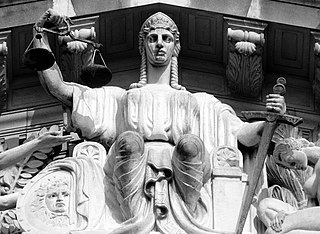Administrative law is a division of law governing the activities of executive branch agencies of government. Administrative law includes executive branch rule making, adjudication, and the enforcement of laws. Administrative law is considered a branch of public law.
In law, certiorari is a court process to seek judicial review of a decision of a lower court or government agency. Certiorari comes from the name of an English prerogative writ, issued by a superior court to direct that the record of the lower court be sent to the superior court for review. The term is Latin for "to be made more certain", and comes from the opening line of such writs, which traditionally began with the Latin words "Certiorari volumus...".

The High Court of Australia is Australia's apex court. It exercises original and appellate jurisdiction on matters specified within Australia's Constitution.

A tribunal, generally, is any person or institution with authority to judge, adjudicate on, or determine claims or disputes—whether or not it is called a tribunal in its title. For example, an advocate who appears before a court with a single judge could describe that judge as "their tribunal." Many governmental bodies that are titled as "tribunals" are described so in order to emphasize that they are not courts of normal jurisdiction. For example, the International Criminal Tribunal for Rwanda was a body specially constituted under international law; in Great Britain, employment tribunals are bodies set up to hear specific employment disputes. In many cases, the word tribunal implies a judicial body with a lesser degree of formality than a court, in which the normal rules of evidence and procedure may not apply, and whose presiding officers are frequently neither judges, nor magistrates. Private judicial bodies are also often styled "tribunals." The word tribunal, however, is not conclusive of a body's function—for example, in Great Britain, the Employment Appeal Tribunal is a superior court of record.

Duncan James Colquhoun Kerr, SC is a barrister. He is a former justice of the Federal Court of Australia. He also served as President of the Administrative Appeals Tribunal from 2012 to 2017.
The court system of Canada forms the country's judiciary, formally known as "The King on the Bench", which interprets the law and is made up of many courts differing in levels of legal superiority and separated by jurisdiction. Some of the courts are federal in nature, while others are provincial or territorial.
The judiciary of Australia comprises judges who sit in federal courts and courts of the States and Territories of Australia. The High Court of Australia sits at the apex of the Australian court hierarchy as the ultimate court of appeal on matters of both federal and State law.
The separation of powers in Australia is the division of the institutions of the Australian government into legislative, executive and judicial branches. This concept is where legislature makes the laws, the executive put the laws into operation, and the judiciary interprets the laws; all independently of each other. The term, and its occurrence in Australia, is due to the text and structure of the Australian Constitution, which derives its influences from democratic concepts embedded in the Westminster system, the doctrine of "responsible government" and the United States version of the separation of powers. However, due to the conventions of the Westminster system, a strict separation of powers is not always evident in the Australian political system, with little separation between the executive and the legislature, with the executive required to be drawn from, and maintain the confidence of, the legislature; a fusion.
Australian administrative law defines the extent of the powers and responsibilities held by administrative agencies of Australian governments. It is basically a common law system, with an increasing statutory overlay that has shifted its focus toward codified judicial review and to tribunals with extensive jurisdiction.

The Administrative Appeals Tribunal (AAT) is an Australian tribunal that conducts independent merits review of administrative decisions made under Commonwealth laws of the Australian Government. The AAT review decisions made by Australian Government ministers, departments and agencies, and in limited circumstances, decisions made by state government and non-government bodies. They also review decisions made under Norfolk Island laws. It is not a court and not part of the Australian court hierarchy; however, its decisions are subject to review by the Federal Court of Australia and the Federal Circuit Court of Australia. The AAT was established by the Administrative Appeals Tribunal Act 1975 and started operation in 1976.

The Federal Court of Australia is an Australian superior court of record which has jurisdiction to deal with most civil disputes governed by federal law, along with some summary and indictable criminal matters. Cases are heard at first instance mostly by single judges. In cases of importance, a Full Court comprising three judges can be convened upon determination by the Chief Justice. The Court also has appellate jurisdiction, which is mostly exercised by a Full Court comprising three judges, the only avenue of appeal from which lies to the High Court of Australia. In the Australian court hierarchy, the Federal Court occupies a position equivalent to the supreme courts of each of the states and territories. In relation to the other courts in the federal stream, it is superior to the Federal Circuit and Family Court of Australia for all jurisdictions except family law. It was established in 1976 by the Federal Court of Australia Act.

In most legal jurisdictions, a supreme court, also known as a court of last resort, apex court, and highcourt of appeal, is the highest court within the hierarchy of courts. Broadly speaking, the decisions of a supreme court are not subject to further review by any other court. Supreme courts typically function primarily as appellate courts, hearing appeals from decisions of lower trial courts, or from intermediate-level appellate courts.

The Federal Circuit Court of Australia, formerly known as the Federal Magistrates Court of Australia or the Federal Magistrates Service, was an Australian court with jurisdiction over matters broadly relating to family law and child support, administrative law, admiralty law, bankruptcy, copyright, human rights, industrial law, migration, privacy and trade practices.

In the United Kingdom, a tribunal is a specialist court with jurisdiction over a certain area of civil law. They are generally designed to be more informal and accessible than 'traditional' courts.

Robert Shenton French is an Australian lawyer and judge who served as the twelfth Chief Justice of Australia, in office from 2008 to 2017. He has been the chancellor of the University of Western Australia since 2017.

Judicial review is a process under which executive, legislative and administrative actions are subject to review by the judiciary. A court with authority for judicial review may invalidate laws, acts and governmental actions that are incompatible with a higher authority: an executive decision may be invalidated for being unlawful or a statute may be invalidated for violating the terms of a constitution. Judicial review is one of the checks and balances in the separation of powers: the power of the judiciary to supervise the legislative and executive branches when the latter exceed their authority. The doctrine varies between jurisdictions, so the procedure and scope of judicial review may differ between and within countries.

An ouster clause or privative clause is, in countries with common law legal systems, a clause or provision included in a piece of legislation by a legislative body to exclude judicial review of acts and decisions of the executive by stripping the courts of their supervisory judicial function. According to the doctrine of the separation of powers, one of the important functions of the judiciary is to keep the executive in check by ensuring that its acts comply with the law, including, where applicable, the constitution. Ouster clauses prevent courts from carrying out this function, but may be justified on the ground that they preserve the powers of the executive and promote the finality of its acts and decisions.
Grant Huscroft is a Canadian jurist and legal scholar, who currently serves as a justice of the Court of Appeal for Ontario.

Hunter Valley Developments Pty Ltd v Cohen is a 1984 decision of the Federal Court of Australia about the discretion to allow applications for review an administrative decision under section 11 of the Administrative Decisions Act 1977 that were made later that the statutory limits allowed.

Alan Robertson is a former judge of the Federal Court of Australia. He served as a deputy president of the Administrative Appeals Tribunal, and retired from the Court in May 2020 having reached the mandatory retirement age for federal judicial appointments.










